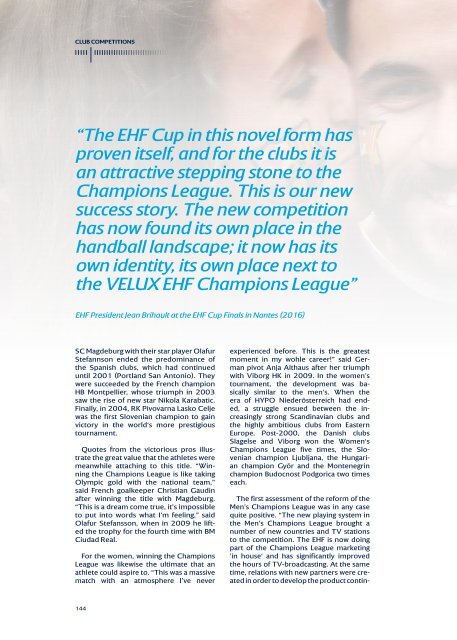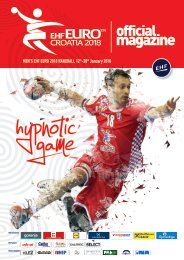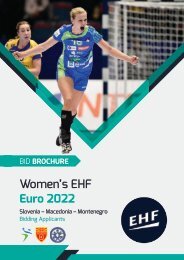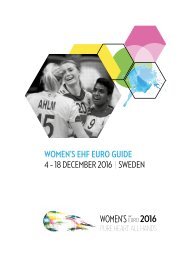ehf_25yers_book_webversion
Create successful ePaper yourself
Turn your PDF publications into a flip-book with our unique Google optimized e-Paper software.
CLUB COMPETITIONS<br />
“The EHF Cup in this novel form has<br />
proven itself, and for the clubs it is<br />
an attractive stepping stone to the<br />
Champions League. This is our new<br />
success story. The new competition<br />
has now found its own place in the<br />
handball landscape; it now has its<br />
own identity, its own place next to<br />
the VELUX EHF Champions League”<br />
EHF President Jean Brihault at the EHF Cup Finals in Nantes (2016)<br />
SC Magdeburg with their star player Olafur<br />
Stefannson ended the predominance of<br />
the Spanish clubs, which had continued<br />
until 2001 (Portland San Antonio). They<br />
were succeeded by the French champion<br />
HB Montpellier, whose triumph in 2003<br />
saw the rise of new star Nikola Karabatic.<br />
Finally, in 2004, RK Pivovarna Lasko Celje<br />
was the first Slovenian champion to gain<br />
victory in the world‘s more prestigious<br />
tournament.<br />
Quotes from the victorious pros illustrate<br />
the great value that the athletes were<br />
meanwhile attaching to this title. “Winning<br />
the Champions League is like taking<br />
Olympic gold with the national team,”<br />
said French goalkeeper Christian Gaudin<br />
after winning the title with Magdeburg.<br />
“This is a dream come true, it’s impossible<br />
to put into words what I’m feeling,” said<br />
Olafur Stefansson, when in 2009 he lifted<br />
the trophy for the fourth time with BM<br />
Ciudad Real.<br />
For the women, winning the Champions<br />
League was likewise the ultimate that an<br />
athlete could aspire to. “This was a massive<br />
match with an atmosphere I’ve never<br />
experienced before. This is the greatest<br />
moment in my wohle career!” said German<br />
pivot Anja Althaus after her triumph<br />
with Viborg HK in 2009. In the women’s<br />
tournament, the development was basically<br />
similar to the men’s. When the<br />
era of HYPO Niederösterreich had ended,<br />
a struggle ensued between the increasingly<br />
strong Scandinavian clubs and<br />
the highly ambitious clubs from Eastern<br />
Europe. Post-2000, the Danish clubs<br />
Slagelse and Viborg won the Women‘s<br />
Champions League five times, the Slovenian<br />
champion Ljubljana, the Hungarian<br />
champion Györ and the Montenegrin<br />
champion Budocnost Podgorica two times<br />
each.<br />
The first assessment of the reform of the<br />
Men’s Champions League was in any case<br />
quite positive. “The new playing system in<br />
the Men’s Champions League brought a<br />
number of new countries and TV stations<br />
to the competition. The EHF is now doing<br />
part of the Champions League marketing<br />
’in house‘ and has significantly improved<br />
the hours of TV-broadcasting. At the same<br />
time, relations with new partners were created<br />
in order to develop the product contin-<br />
144














